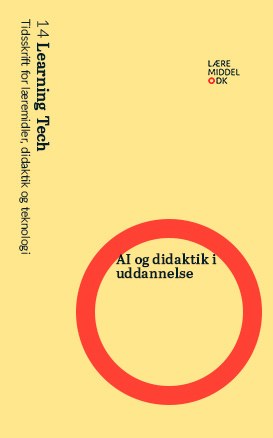Måling af flydende læsning med øjenbevægelser i skolen
Eye-tracking kan måle variation i læse- og stavefærdigheder under selvstændig læsning i 4. kl.
DOI:
https://doi.org/10.7146/lt.v9i14.137119Resumé
Eye-tracking-teknologien er blevet tilgængelig for måling af elevers læsning i skolen. I en skolehverdag skal eye-tracking-data kunne omsættes til pålidelige mål med praktisk relevans, fx til undervisningsevaluering. Dette studie præsenterer øjenbevægelsesmålet fokusord, der er udviklet til at opmærke nedbrud i elevers flydende læsning og dermed et forsøg på at oversætte eye-tracking-data til læsefaglig indsigt. Studiet er designet til at validere målets pålidelighed som læse-/ stave-indikator og endvidere målemetodens robusthed. 84 elever fra fem 4.-klasser deltog, hvoraf data fra 68 elever indgår. Udover elevernes eksisterende resultater i læse-/stavetest, optog vi deres øjenbevægelser under selvstændig højtlæsning. Vi finder stærke korrelationer mellem øjenbevægelser og læse-/stavetestresultater, som indikerer målemetodens robusthed. Videre korrelerer fokusord med klassiske øjenbevægelsesmål, hvilket er tegn på samstemmende validitet. Endelig forklarer fokusordene unik variation i elevernes læseforståelseseffektivitet og stavefærdighed ud over, hvad det stærkest korrelerede klassiske mål, fikseringstid, forklarer. Resultaterne understøtter, at fokusordsprocent er robust og tæt forbundet med læse- og stavefærdigheder.
Referencer
Alexander-Passe, N. (2008). The sources and manifestations of stress amongst school-aged dyslexics, compared with sibling controls. Dyslexia: An International Journal of Research and Practice, 14(4), 291-313. https://doi-org.ez-ucs.
statsbiblioteket.dk/10.1002/dys.351
Andersen, D. (2005). 4 år efter grundskolen – 19-årige om valg og veje i ungdomsuddannelserne. København: AKF-forlaget
Benfatto, M. N., Seimyr, G. Ö., Ygge, J., Pansell, T., Rydberg, A. & Jacobson, C. (2016). Screening for dyslexia using eye tracking during reading. PLoS ONE, 11(12), 1-16. https://doi.org/10.1371/journal.pone.0165508
Bundsgaard, J. & Puck, M. R. (2016). Nationale Test – Danske Lærere Og Skolelederes Brug, Holdninger Og Viden. DPU, Aarhus Universitet.
Børne- og undervisningsministeriet (2019). Dansk Fælles Mål. Lokaliseret d. 12. januar 2023 på https://emu.dk/sites/default/files/2020-09/GSK_F%C3%A6llesM%C3%A5l_Dansk.pdf
Børne- og undervisningsministeriet (2022). Folkeskolens Nationale Færdighedstest. Lokaliseret d. 12. januar 2023 på https://www.uvm.dk/folkeskolen/test-evaluering-og-skoleudvikling/test--og-evalueringsredskaber/folkeskolens-
nationale-faerdighedstest
Caravolas, M., Hulme, C. & Snowling, M. (2001). The Foundations of Spelling Ability: Evidence from a 3 Year Longitudinal Study. Journal of Memory and Language – J MEM LANG. 45, 751-774.
Carroll J. M. & Iles J. E. (2006). An assessment of anxiety levels in dyslexic students in higher education. British Journal of Educational Psychology, 76, 651-662.
Christensen, V. T. (2019). PISA 2018 – Danske unge i en international sammenligning. København: VIVE. Det Nationale Forsknings-og Analysecenter for Velfærd.
Elbro, C. (2021). Læsevanskeligheder. Hans Reitzels Forlag. København. ISBN: 9788741263359
Elbro, C. (2014). Læsning og læseundervisning. Hans Reitzels Forlag. København. ISBN: 9788762501799
Franzen, L., Stark, Z. & Johnson, A. P. (2021). Individuals with dyslexia use a different visual sampling strategy to read text. Scientific reports, 11(1), 6449.
Gran Ekstrand, A. C., Nilsson Benfatto, M. & Öqvist Seimyr, G. (2021, March). Screening for Reading Difficulties: Comparing Eye Tracking Outcomes to Neuropsychological Assessments. In Frontiers in Education (Vol. 6, p. 643232). Frontiers Media SA.
Hinkle, D. E., Wiersma, W. & Jurs, S. G. (2003). Applied Statistics for the Behavioral Sciences. Boston, MA: Houghton Mifflin Company.
Holmqvist, K., Nyström, M., Andersson, R., Dewhurst, R., Jarodzka, H. & Van de Weijer, J. (2011). Eye tracking: A comprehensive guide to methods and measures. OUP Oxford.
Juul, H. (2019). Vejledning til staveprøve 1-3. Hogrefe Psykologisk Forlage
Kousholt, K. (2015). “Børns Gætterier Ved Nationale Test”. Cepra-striben, Nationale Tests, nr. 18: 46-57.
Laerd Statistics (2018). Spearman’s correlation using SPSS Statistics. Statistical tutorials and software guides. https://statistics.laerd.com/
Larsen, M., Jakobsen, V. & Rosdahl, A. (2022). Voksnes basale færdigheder. Udvikling i læse- og regnefærdigheder de seneste 10 år. VIVE. e-ISBN: 978-87-7582-071-9
Meister, C., Pimentel, T., Clark, T., Cotterell, R. & Levy, R. (2022). Analyzing Wrap-Up Effects through an Information-Theoretic Lens. In Proceedings of the 60th Annual Meeting of the Association for Computational Linguistics (Volume 2: Short Papers) (pp. 20-28).
Møller, L. (2013). Vejledning til tekstlæseprøve 1-8. Hogrefe Psykologisk Forlag
Nelson, J. M., Lindstrom, W. & Foels, P. A. (2015). Test Anxiety Among College
Students With Specific Reading Disability (Dyslexia): Nonverbal Ability and Working Memory as Predictors. Journal of Learning Disabilities, 48(4), 422-432. https://doi.org/10.1177/0022219413507604
Ravn, K. (2015). “Duer ikke: En femtedel af opgaverne i de nationale test kasseret –
Folkeskolen.dk”. folkeskolen.dk. https://www.folkeskolen.dk/572751/duer-ikke-
en-femtedel-af-opgaverne-i-de-nationale-testkasseret
Rayner, K. (1998). Eye movements in reading and information processing: 20
years of research. Psychological bulletin, 124(3), 372.
Rosdahl, A., Fridberg, T., Jakobsen, V. & Jørgensen, M. (2013): ”Færdigheder i
læsning, regning og problemløsning med IT”. København: SFI – Det Nationale
Forskningscenter for Velfærd
Rosdahl, A., Fridberg, T., Jakobsen, V. & Jørgensen, M. (2013): ”Færdigheder i læsning, regning og problemløsning med IT. Sammenfatning af resultater fra PIAAC”. København: SFI – Det Nationale Forskningscenter for Velfærd.
Sperlich, A., Schad, D. J. & Laubrock, J. (2015). When preview information starts to matter: Development of the perceptual span in German beginning readers.
Journal of Cognitive Psychology, 27(5), 511-530. Swalander, L (2012). Selvbillede, motivation og dysleksi. In Samuelsson (Ed.) Dysleksi og andre vanskeligheder med skriftsproget (pp. 178-191). Dansk Psykologisk Forlag.
Von der Malsburg, T. & Vasishth, S. (2011). What is the scanpath signature of syntactic reanalysis?. Journal of Memory and Language, 65(2), 109-127.
Wangebo, K. (2011), Running record en systematisk og detaljeret iagttagelse af læseadfærd. Viden om Læsning, 9, 23-30. Nationalt Videncenter for Læsning.
Yderligere filer
Publiceret
Citation/Eksport
Nummer
Sektion
Licens
Forfatterne og Læremiddel.dk.
Må ikke bruges kommercielt.


